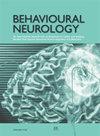Graph Theoretical Analysis of Semantic Fluency in Patients with Parkinson's Disease
IF 2.7
4区 医学
Q2 CLINICAL NEUROLOGY
引用次数: 2
Abstract
Semantic fluency is the ability to name items from a given category within a limited time, which relies on semantic memory, working memory, and executive function. Semantic disfluency is a common problem in Parkinson's disease (PD) and Alzheimer's disease (AD). We demonstrated a graph theoretical analysis of semantic fluency in patients with PD (N = 86), patients with AD (N = 40), and healthy controls (HC, N = 88). All participants completed a standard animal fluency test. Their verbal responses were recorded, transcripted, and transformed into directed speech graphs. Patients with PD generated fewer correct words than HC and more correct words than patients with AD. Patients with PD showed higher density, shorter diameter, and shorter average shortest path length than HC, but lower density, longer diameter, and longer average shortest path length than patients with AD. It suggests that patients with PD produced relatively smaller and denser speech graphs. Moreover, in PD, the densities of speech graphs correlated with the severity of non-motor symptoms, but not the severity of motor symptoms. The graph theoretical analysis revealed new features of semantic disfluency in patients with PD.帕金森病患者语义流畅性的图论分析
语义流利性是指在有限的时间内从给定类别中命名项目的能力,这取决于语义记忆、工作记忆和执行功能。语义障碍是帕金森病(PD)和阿尔茨海默病(AD)的常见问题。我们对PD患者(N=86)、AD患者(N=40)和健康对照组(HC,N=88)的语义流畅性进行了图论分析。所有参与者都完成了标准的动物流畅性测试。他们的言语反应被记录、转录并转化为有向言语图。PD患者产生的正确单词比HC少,比AD患者产生的准确单词多。PD患者比HC表现出更高的密度、更短的直径和更短的平均最短路径长度,但比AD患者表现出更低的密度、更长的直径和更长的平均最长路径长度。这表明PD患者产生相对更小、更密集的语音图。此外,在PD中,语音图的密度与非运动症状的严重程度相关,但与运动症状的程度无关。图论分析揭示了帕金森病患者语义障碍的新特点。
本文章由计算机程序翻译,如有差异,请以英文原文为准。
求助全文
约1分钟内获得全文
求助全文
来源期刊

Behavioural Neurology
医学-临床神经学
CiteScore
5.40
自引率
3.60%
发文量
52
审稿时长
>12 weeks
期刊介绍:
Behavioural Neurology is a peer-reviewed, Open Access journal which publishes original research articles, review articles and clinical studies based on various diseases and syndromes in behavioural neurology. The aim of the journal is to provide a platform for researchers and clinicians working in various fields of neurology including cognitive neuroscience, neuropsychology and neuropsychiatry.
Topics of interest include:
ADHD
Aphasia
Autism
Alzheimer’s Disease
Behavioural Disorders
Dementia
Epilepsy
Multiple Sclerosis
Parkinson’s Disease
Psychosis
Stroke
Traumatic brain injury.
 求助内容:
求助内容: 应助结果提醒方式:
应助结果提醒方式:


